Honest Abe in Fort Wayne, IN
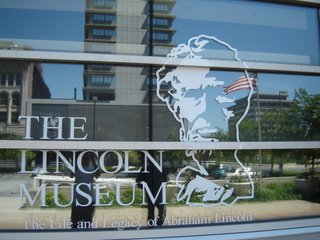 Today I visited the Lincoln Museum in Fort Wayne, IN. It seems that a million states claim former United States President Abraham "Honest Abe" Lincoln as his hometown, and Indiana is one of them.
Today I visited the Lincoln Museum in Fort Wayne, IN. It seems that a million states claim former United States President Abraham "Honest Abe" Lincoln as his hometown, and Indiana is one of them. The museum is filled with mock ups and an explanation of Abe's life, Presidency, and legacy. Being that Lincoln is my favorite former President, I had a great time. While the museum seems short on original artifacts, what they do have is interesting. For instance, this document above attests to the sale of a mother (Ann, 22) and her daughter Emeline (3). The artifact seems as a deed of sale or a certificate of authenticity. It brings you back to a time when people could be property and slavery was legal.
The museum is filled with mock ups and an explanation of Abe's life, Presidency, and legacy. Being that Lincoln is my favorite former President, I had a great time. While the museum seems short on original artifacts, what they do have is interesting. For instance, this document above attests to the sale of a mother (Ann, 22) and her daughter Emeline (3). The artifact seems as a deed of sale or a certificate of authenticity. It brings you back to a time when people could be property and slavery was legal.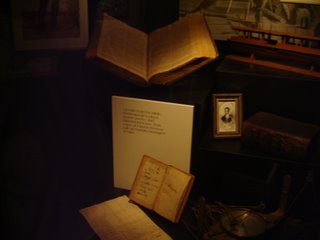 With this backdrop, some of Lincoln's childhood and early adult artifacts are on display. In 1816, Lincoln's parents moved him from Kentucky to Indiana in part due to the slavery issue, but mostly due to the fact that land was easier to get in their new home. Abe's mother would die when he was nine, and his father would quickly remarry.
With this backdrop, some of Lincoln's childhood and early adult artifacts are on display. In 1816, Lincoln's parents moved him from Kentucky to Indiana in part due to the slavery issue, but mostly due to the fact that land was easier to get in their new home. Abe's mother would die when he was nine, and his father would quickly remarry. The museum had a copy of the famous Lincoln-Douglas debates, the standard for formal debating in our country.
The museum had a copy of the famous Lincoln-Douglas debates, the standard for formal debating in our country.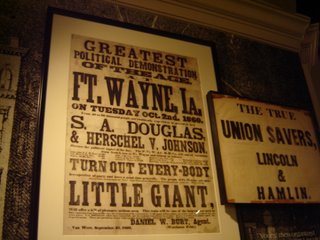 Stephen A. Douglas would defeat Lincoln for a U.S. Senate seat in 1958.
Stephen A. Douglas would defeat Lincoln for a U.S. Senate seat in 1958.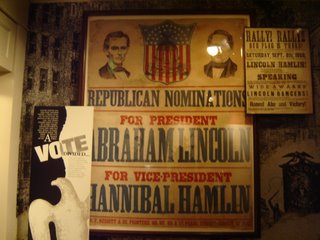 Lincoln would return the favor in 1860 and beat him for the United States presidency.
Lincoln would return the favor in 1860 and beat him for the United States presidency.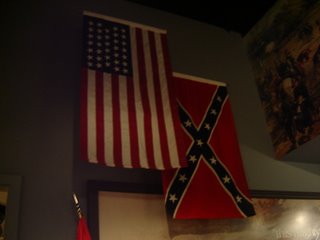 Lincoln's legacy as president, obviously, will forever be linked with the Civil War. What I did not realize, due to my Lincoln worship, that the legacy of preserving the Union had some unfortunate consequences. Lincoln signed bills authorizing a federal military draft and income tax, both of which have had repercussions for generations of Americans long after the Civil War was over.
Lincoln's legacy as president, obviously, will forever be linked with the Civil War. What I did not realize, due to my Lincoln worship, that the legacy of preserving the Union had some unfortunate consequences. Lincoln signed bills authorizing a federal military draft and income tax, both of which have had repercussions for generations of Americans long after the Civil War was over. One fun area of the museum is a collection of Lincoln photographs.
One fun area of the museum is a collection of Lincoln photographs.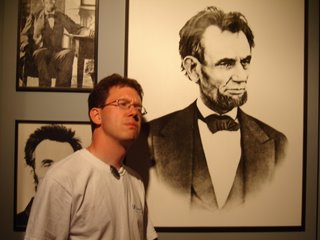 Lincoln was a thoughtful, serious man that I can relate to.
Lincoln was a thoughtful, serious man that I can relate to.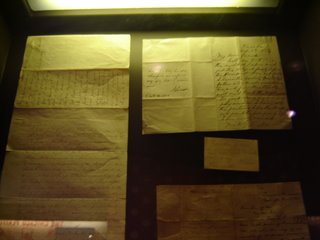 The Lincoln museum is at its best when it show items on display relating to Lincoln's life. Here are some letters and other items signed by the former president.
The Lincoln museum is at its best when it show items on display relating to Lincoln's life. Here are some letters and other items signed by the former president.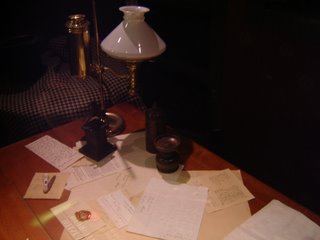 Also on display were items once on his desk.
Also on display were items once on his desk. Lincoln did not have much time to celebrate the Civil War victory. Lincoln was shot and killed by an actor and Southerner using a single shot .44 caliber Darringer pistol like this one on display. It's hard to imagine this thing killing someone, but Lincoln did get shot in the head at nearly point blank range.
Lincoln did not have much time to celebrate the Civil War victory. Lincoln was shot and killed by an actor and Southerner using a single shot .44 caliber Darringer pistol like this one on display. It's hard to imagine this thing killing someone, but Lincoln did get shot in the head at nearly point blank range. This towel was used at the deathbed of Lincoln. It's possible his DNA is on it, and we may someday be able to clone him. Once that happens, we'll finally no longer have Bush family members in the White House.
This towel was used at the deathbed of Lincoln. It's possible his DNA is on it, and we may someday be able to clone him. Once that happens, we'll finally no longer have Bush family members in the White House.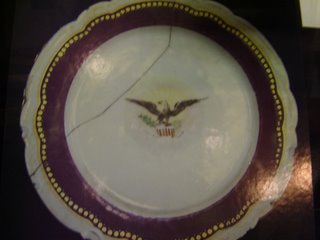 Then we can use plates from his White House again and all will be well.
Then we can use plates from his White House again and all will be well.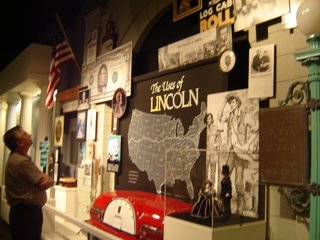 Near the end of the museum, there's a section titled the "Uses of Lincoln".
Near the end of the museum, there's a section titled the "Uses of Lincoln". They are mostly commercial. Like Honest Abe with a Budweiser cap on saying "All Beers Are Not Created Equal." Clever.
They are mostly commercial. Like Honest Abe with a Budweiser cap on saying "All Beers Are Not Created Equal." Clever. There is also an art gallery of Lincoln images and quotes.
There is also an art gallery of Lincoln images and quotes.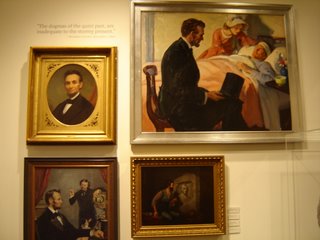 One interesting quote comes from Lincoln:
One interesting quote comes from Lincoln:If A. can prove, however conclusively, that he may, of right, enslave B. -- why may not B. snatch the same argument, and prove equally, that he may enslave A?--In this system I'd be OK though, since I have very fair skin. I don't think that was his point though.
You say A. is white, and B. is black. It is color, then; the lighter, having the right to enslave the darker? Take care. By this rule, you are to be slave to the first man you meet, with a fairer skin than your own.
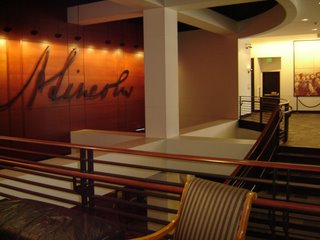 While the upstairs is the home of the museum's permanent collection, there is a stairway leading down that takes you to their temporary exhibit.
While the upstairs is the home of the museum's permanent collection, there is a stairway leading down that takes you to their temporary exhibit. The topic of this one was Lincoln, the Constitution, and the Civil War.
The topic of this one was Lincoln, the Constitution, and the Civil War. A highlight of the exhibit is a signed copy of the Emancipation Proclamation, the order that freed the slaves in Confederate States. Lincoln signed this document so he could sell it in order to benefit Union soldiers.
A highlight of the exhibit is a signed copy of the Emancipation Proclamation, the order that freed the slaves in Confederate States. Lincoln signed this document so he could sell it in order to benefit Union soldiers. Also on display is a copy of the Thirteenth Amendment to the U.S. Constitution, which abolished slavery. Lincoln was so adamant about it that he signed the document before it was ratified by the states, which was seen by the United States Senate as an assault on the separation of powers. The senate passed a resolution stating that his signing should not be seen as a precedent. This is one of the thirteen copies he is believed to have signed.
Also on display is a copy of the Thirteenth Amendment to the U.S. Constitution, which abolished slavery. Lincoln was so adamant about it that he signed the document before it was ratified by the states, which was seen by the United States Senate as an assault on the separation of powers. The senate passed a resolution stating that his signing should not be seen as a precedent. This is one of the thirteen copies he is believed to have signed. He did not have a bad signature.
He did not have a bad signature.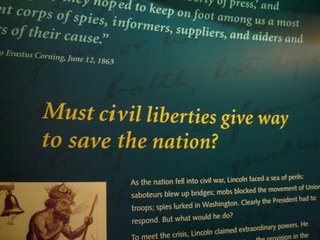 The real power of the exhibit however is how history is brought into today's context. Lincoln waived habeas corpus for the first time, started a draft, and created an income tax. Lincoln did preserve the Union, but did it in a way that many Americans today would not appreciate when it comes to personal liberties. In some cases, people were detained or arrested for speaking against the war, denouncing the draft, or publishing articles criticizing the government. Our current President Bush has done less and has been criticized accordingly. In this case, Lincoln is a hero because he won. Will George W. also be treated that way by history?
The real power of the exhibit however is how history is brought into today's context. Lincoln waived habeas corpus for the first time, started a draft, and created an income tax. Lincoln did preserve the Union, but did it in a way that many Americans today would not appreciate when it comes to personal liberties. In some cases, people were detained or arrested for speaking against the war, denouncing the draft, or publishing articles criticizing the government. Our current President Bush has done less and has been criticized accordingly. In this case, Lincoln is a hero because he won. Will George W. also be treated that way by history?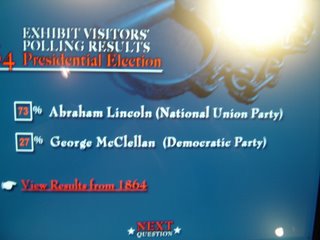 You can even revote the 1864 election. Oddly enough, in the Abraham Lincoln museum, 27% of voters selected George McClellan.
You can even revote the 1864 election. Oddly enough, in the Abraham Lincoln museum, 27% of voters selected George McClellan.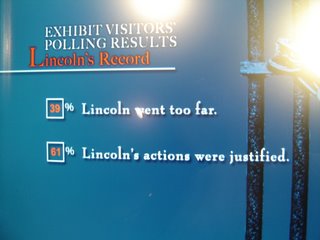 In this poll, 39% of voters in his museum said he went too far. When you put things in context, it is surprising how hero worship ends and today's political beliefs come into play.
In this poll, 39% of voters in his museum said he went too far. When you put things in context, it is surprising how hero worship ends and today's political beliefs come into play.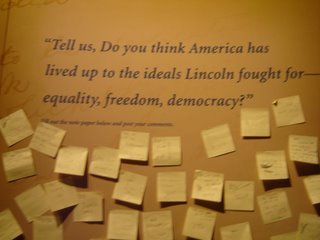 The end of the exhibit invites visitors to put up Post-It notes answering the question, "do you think America has lived up to the ideals Lincoln fought for -- equality, freedom, democracy?"
The end of the exhibit invites visitors to put up Post-It notes answering the question, "do you think America has lived up to the ideals Lincoln fought for -- equality, freedom, democracy?" Some of the answers were quite amusing.
Some of the answers were quite amusing. The exhibit leaves us with a challenge to us to keep our Republic strong and free. How we are to do that -- or if we will -- is up to us.
The exhibit leaves us with a challenge to us to keep our Republic strong and free. How we are to do that -- or if we will -- is up to us.RELATED LINKS:
An online anthology to American Slavery



0 Comments:
Post a Comment
|<< Home